I signed up for another trip to Norfolk. This time it was a one day visit to The Brecks with a new (to me) company - The Bird ID Company run by Marcus Nash. 5 of us packed into his Ford Galaxy and we toured around this fabulous area.
We saw some extraordinary birds including a pair of Lesser Spotted Woodpeckers preparing to build a nest, a pair of Stone Curlews and a whole host of passerines. Marcus' report is so comprehensive and professional that I have copied it in total below. See for yourself why this area of Norfolk is a must visit zone.
It was another lovely day – bright and sunny, though still with a bit of a chill to the east wind. It still felt like spring though, out of the wind, a great day to be out birding.
We saw some extraordinary birds including a pair of Lesser Spotted Woodpeckers preparing to build a nest, a pair of Stone Curlews and a whole host of passerines. Marcus' report is so comprehensive and professional that I have copied it in total below. See for yourself why this area of Norfolk is a must visit zone.
It was another lovely day – bright and sunny, though still with a bit of a chill to the east wind. It still felt like spring though, out of the wind, a great day to be out birding.
The meeting place at the start of the day was at Lynford. As we gathered in the car park, we could hear a Blackcap singing, the first we have heard this year. There seems to have been quite an arrival of them in the last couple of days. We looked across and could see it perched up in the top of a bare deciduous tree nearby.
Over on the other side of the car park, we could hear a Firecrest calling. We walked over and realised it was out on the sunny side of the trees, by the road. When we got round there, it had moved up into the tops of the trees, and was calling constantly. There were lots of other birds up there too, Siskins, Chaffinches and tits. Then a second Firecrest started calling nearby, from a low holly bush right in front of us. As it was much lower down, we had a great view of it in there for a couple of seconds, before it too flew up into the tops of the trees.
Back in the car park, we could still hear the Firecrests calling from high up in the trees, where the sun was catching them. A Jay perched in the very top of a fir tree was also enjoying the morning sunshine.
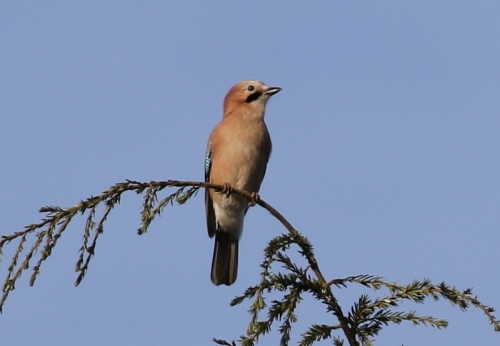
Jay – enjoying the morning sunshine at Lynford
Our first destination for the day was Santon Downham – we planned to come back to explore Lynford later. We drove over into Suffolk, parked in the Forestry Commission car park, and walked back down the road towards the bridge. There were quite a few Bramblings in the alders down by the river and some of them were singing. The song is not much to write home about – a hoarse wheezing rather like a Greenfinch. They should be on their way back to Scandinavia for the breeding season soon.

Brambling – singing in the alders down by the river
As we walked down along the river bank, we could hear the ‘glipping’ calls of Common Crossbills and looked across to see two flying away over the meadows. A little further along we heard our first Mandarins calling. A pair flew in from the other side of the river and did a circuit through the trees, the male following the female, before the two of them eventually landed high in a poplar. It is always slightly odd to see Mandarins balancing in the trees, but they are naturally tree hole nesters.

Mandarin – the drake, balanced high in a poplar tree
A raptor appeared over the top of the trees and a quick look confirmed it was an adult Goshawk. Silvery grey above and rather bright white below, it flew across low over the top of the poplars and dropped away behind the pines beyond. A nice bonus to start the day.
There are still lots of Lesser Redpolls along the river at the moment. Most of them are feeding down in the sallows and alders at the back of the trees, out of view. Odd ones and twos were chasing each other around higher up in the trees and we managed to get some in the scope for a closer look.
The Nuthatches are very noisy along the river at the moment, busy renovating their homes and defending them from any other unwelcome potential occupants. A Great Spotted Woodpecker called and appeared briefly on a branch above the path ahead of us, before flying back into the trees. A couple of Green Woodpeckers laughed at us from the other side of the river.
What we really wanted to see was Lesser Spotted Woodpecker though. We had been lucky enough to be able to watch the male fly in and start excavating a nest hole yesterday, so it was only natural to have a quick look at the same tree this morning, just in case. And there it was! The male Lesser Spotted Woodpecker was busy in exactly the same spot. It was hard to see at first, slightly round towards the back of the tree, in the shade, but we got all the scopes on it and we were all soon watching it hard at work.
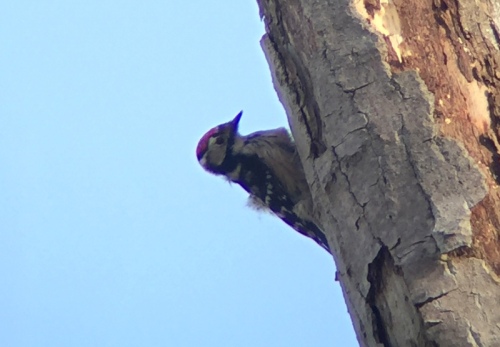
Lesser Spotted Woodpecker – the male, with red crown, busy excavating again
The Lesser Spotted Woodpecker was disappearing most of the way into the hole – we could just see its tail showing behind the trunk – and re-emerging with beak-fulls of wood chips, which it would throw out. It was mostly in the shade on that side of the tree, but occasionally when it leaned back and turned, its bright red crown caught in the morning sunshine.
We watched the male Lesser Spotted Woodpecker busy working on the hole for about 15 minutes. Then it seemed to pause and started calling. We thought we might hear the female answer from somewhere nearby, although we didn’t hear anything. But the next thing we knew, the female Lesser Spotted Woodpecker appeared in a tree nearby. She didn’t fly to inspect the nest hole today, but instead flew straight towards us and landed in a tree right above our heads. Craning our necks, we could see her feeding in the high branches. She flitted between branches for a couple of minutes, before flying off across the river. When we looked back, the male had now disappeared too.
We walked a little further up along the river, to see what else we could find. A pair of Stock Doves were hopping around in a large dead tree. A Water Rail flew into cover on the far bank of the river, but before anyone could get onto it. There were several butterflies out enjoying the spring sunshine – Red Admiral, Peacock and Small Tortoiseshell. On our way back again, there was still no sign of the Lesser Spotted Woodpecker back at the nest hole, so we decided to move on.
On the walk back, a pair of Mandarins were by the river. The female was out on the bank, preening, while the male swam up and down in the edge of the water. He looked particularly smart, his bright chestnut plumage catching the sun, with his thick mane of ornamental feathers around his neck and two ‘sails’ on his back.
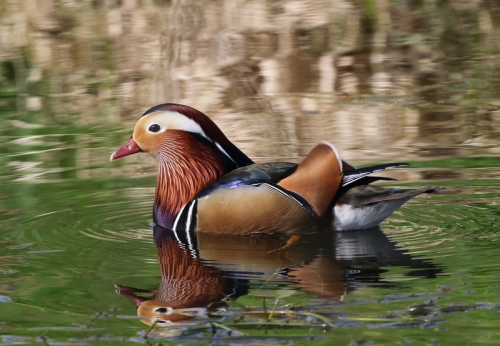
Mandarin – a pair were on the river on the way back
On the way back from the bridge to the car park, we noticed a small bird making aerial sallies out from the side of a tall conifer. It was a Firecrest and it was flycatching, fluttering out after small flies which we could see in the air around the edge of the tree. We stopped to watch it for a couple of minutes. When it landed in the edge of the conifer, we could see its boldly black and white striped face and the brighter bronze patches on the sides of the neck. A lovely bird!
Our next stop was in the north Brecks. We parked in an area overlooking the Forest and got out to scan over the trees. Despite the sunshine, there was still a bit of a chill from the easterly wind, and raptor activity was a little slow here today. There were a few Common Buzzards circling up above the trees. A couple of Red Kites were displaying in the distance, and stopped to chase off another Common Buzzard which was trying to circle with them. A Sparrowhawk came up out of the trees too – just too small to be a Goshawk, with a more active flapping flight and quicker turns. As it circled we could see its square-cornered tail, pinched in at the base. A pair of Kestrels circled over the field nearby.
There has been a pair of Stone Curlews in the field behind, but we couldn’t see them at first. They had settled down in among the stones and clods of earth, in a slight depression in the field, and were perfectly camouflaged. There was also a bit of heat haze now, coming up off the bare ground. We repositioned ourselves slightly and scanned carefully and just managed to see two heads, which looked to all intents and purposes like two rather rounded stones! Through the scope, we could just make out the staring yellow iris in the middle of one of the ‘stones’!
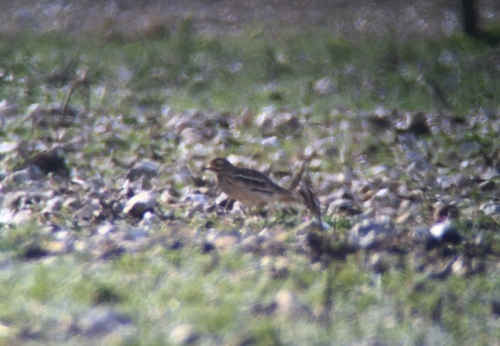
Stone Curlew – one standing up, one hiding in among the stones
Helpfully, after a few minutes, one of the two Stone Curlews stood up so we could get a much better look at it. We could see the distinctive black and white striped panel on the wings.
A Woodlark called and we looked across to see it fluttering over the winter wheat field in front. It flew around for a minute or so and then dropped down to the ground. We saw where it landed, but it quickly disappeared into the crop before we could get the scopes onto it. A short while later, we could hear either it or another Woodlark singing its rather sad and melancholy song from somewhere across the field.
With the limited raptor activity here, we decided to move on and have a look for the Great Grey Shrike first, and come back here for lunch later. We parked by another ride and set off into the Forest. A smart male Yellowhammer was calling from the trees on the edge of the clearing. There was no sound of any Woodlarks today, but there were several dogs running around loose all over the middle of the clearing, not an ideal situation with sensitive ground nesting birds here!
As soon as we rounded the corner by the young pine plantation, we could see the Great Grey Shrike, its bright white and silvery grey plumage really standing out in the sun against the background of dark green pines. We had a quick look from the corner, and then made our way round to the other side of the plantation where we could get a better look with the sun behind us.
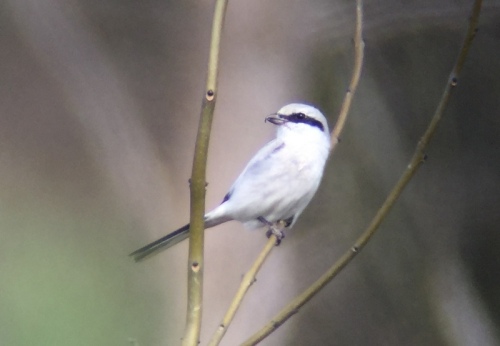
Great Grey Shrike – showing well in its usual spot again today
We watched the Great Grey Shrike for a while. It perched in the very top of a young pine tree for a while, before dropping down to the ground. When it came back up, it climbed through the branches of a young ash tree. It stayed there for some time, scanning the ground below. While we were watching it, a Woodlark flew up from the clearing behind and landed in the top of a tall, lone dead pine. Through the scope we could see the prominent pale supercilium and the distinctive black and white panel on the primary coverts.
It was time for lunch, so we headed back to the spot where we had been earlier and scanned over the Forest as we ate. There seemed to be a bit more hazy cloud at first, and it felt even slightly cooler than it had earlier. The raptors were still fairly subdued. However, after a while some blue sky appeared over the trees and we could feel the sun a little stronger on our backs. It was just enough – an adult male Goshawk circled up out of the trees below a Common Buzzard. It didn’t stop long though, and quickly drifted off and dropped away over the pines.
The plan was to spend the rest of the afternoon back at Lynford Arboretum. The Hawfinches have been showing very well over the last few days from the gate, so we got ourselves into position. We could see one Hawfinch come down through the trees and it quickly dropped to the ground to feed, but it was right at the back and hard to see behind some taller evergreen vegetation. There were also a pair of Bullfinches feeding in the leaf litter at the back.
A couple of Bramblings were more obliging, feeding in the leaf litter much closer to the gate. One or two Siskins dropped down to the stone bath to drink. A Nuthatch flew down to the ground too and several tits were flitting around the feeders.

Brambling – coming down to the feed on the ground in front of the gate
Then we spotted someone walking through the trees at the back, and the Hawfinch and Bullfinches flew off as they approached. They walked through to the chicken run with what looked like some food for the pet rabbit which is also in there. We thought the Hawfinches might return, but the next thing we knew a large crowd of people came through the back of the trees, with a couple of dogs in tow too. They went round to the chicken pen and stayed there for what seemed like ages. It was clear the birds would not be coming back down in a hurry!
We walked on down the path to the pines and did a quick circuit round the trees. We could hear Crossbill calling from the tops, but couldn’t see it. From round by the battle area, we heard a Hawfinch calling from the trees. We stopped to look for it and realised that there were loads of finches up in the pines – Bramblings, Chaffinches, Lesser Redpolls, Siskins and Goldfinches – all taking advantage of the opening of the cones and the resulting abundance of free seed. The birds were hard to see in the pines though, and we couldn’t see any Hawfinch.
As we walked back to the main path, we could hear another Hawfinch calling from the trees overhead and then we spotted one out in the open in the top of the deciduous trees by the chicken pen. Unfortunately, just as we got it in the scope, it flew off towards the feeders. We walked back to see if we could find it down on the ground from the gate, but it was still all quiet here.
The Hawfinches often like to perch in the tops of the trees around the Arboretum and enjoy the late afternoon sun, so we decided we would walk down towards the bridge and try our luck there. As we got to the top of the hill, we spotted three Hawfinches in the tops of the bare branches. This time most of the group did manage to get a look at them in the scope, but they didn’t hang around and flew back towards the chicken pen. We turned to walk back and one was perched in the top of a tree on the edge of the Arboretum calling, but that too quickly flew.
The Hawfinches were certainly giving us the runaround today, but as we walked back to see if we could find one down on the ground from the gate, we finally all got a good look at one in the tops of the trees above the feeders. Finally! After a few minutes, it dropped down towards the ground, but there was still no sign of it from the gate.

Hawfinch – finally one perched up nicely in the trees for us
The Hawfinches were a bit like buses today. Having finally broken our duck and had a good look at one, as we headed back down the hill once more to look for Crossbills, there were two more Hawfinches in the tops of the trees by the path. Just as we had suggested, they seemed to be enjoying the late afternoon sunshine. Again, we got a really good look at these two through the scopes. They really are stunning birds, with their massive nutcracker bills.
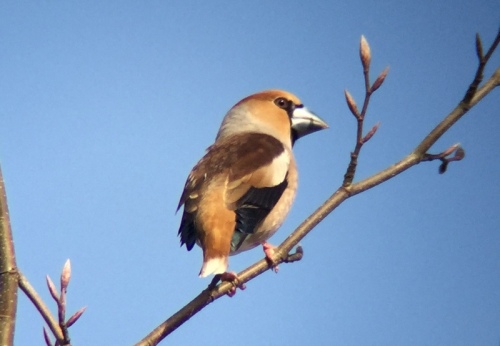
Hawfinch – enjoying the late afternoon sun in the treetops
Down at the bridge, there was quite a bit of food out for the birds today. There was a steady stream of tits coming in to take advantage of it, including a smart Marsh Tit. A couple of Nuthatches kept darting in too, to grab a seed or two. The resident male Reed Bunting was here again too.
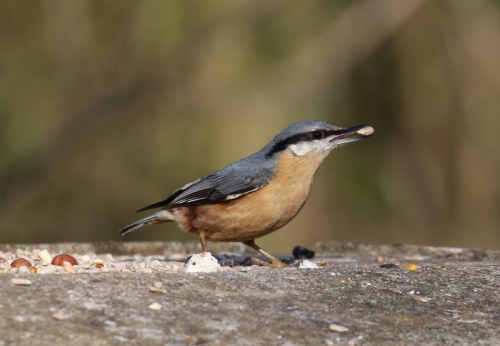
Nuthatch – coming down to the bridge to grab a seed
After a short wait, we heard a Common Crossbill calling. We managed to find it in the top of a poplar but it was deep in the trees and was quickly flushed by a couple of Carrion Crows before everyone could get onto it and dropped down towards the ground, presumably to drink. We walked back towards the start of the Woodland Walk and could see a couple of Crossbills flying around in the trees, although they were very hard to see in the dense tangles of branches.
Thankfully, as we set off in to the wood in an attempt to try to get everyone to see them, the pair of Crossbills flew out and across the path, landing in a spruce tree at the start of the hill. The bright red male helpfully perched right on the outside for a few seconds, long enough for us to get it in the scope. We walked up to the spruce and could see the Crossbills deep in the centre of the tree, and hear them calling, before they flew off.
We walked back over the bridge and along the path, stopping to look at the Long-tailed Tits’ nest hidden in the brambles. It looked to be empty, but as we stood admiring it, we could hear two Long-tailed Tits calling as they approached through the undergrowth. One of them was carrying a large feather. They were clearly too nervous to go in with us standing there, so we backed off.
Another Crossbill flew overhead at that point and we turned to look at it as it landed in the tops of the poplars. It was a rather rusty orange male, possibly an immature, or just lacking in red pigment from its diet. We got it in the scope and had a good look at it, before it dropped down into the trees out of view.
It was already time to head back to the car park now. As we got back to the cars, the Firecrest was singing from the trees nearby, just as it had been when we met first thing this morning. We had enjoyed a long and exciting day in the Brecks in between, and seen some great birds!
No comments:
Post a Comment
Note: only a member of this blog may post a comment.